Click here to print
Detecting the History of Sound-on-Film
posted August 24, 2010
[Clarification added 17 February 2016; see Kinetophone, below.]
By Peter Monaghan
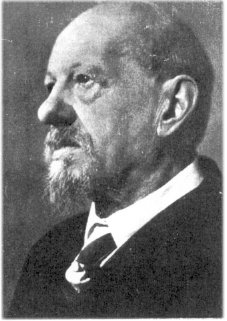
Only 24 frames long, it belongs to an American collector, Rocco Accetturo, who bought it at an estate sale along with other items from Lauste’s undeservedly obscure career. Alongside the frames, which show nondescript images of plants, lies a series of black squiggles that encode sound – perhaps the first sound ever simultaneously reproduced with moving images on the one medium.
It is not particularly impressive sound, to be sure. That was evident on the July 5, 2010 edition of the PBS program, History Detectives, where the footage was featured. (The segment can now be viewed online.)
The producers of the program sent the clip to the University of South Carolina Moving Image Research Collections, where technicians used an archival scanner to discover what the soundtrack – all one second of it – contained.
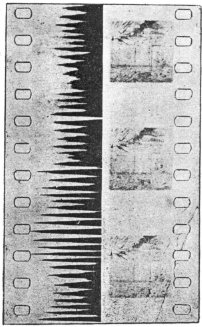
The technicians found sounds that cannot be identified as anything much. Still, sound there is – so indistinct as to seem like distorted scratching, but captured on the film, itself. A similar clip from footage captured by Lauste is held in the Photo History collection of the Smithsonian Museum. It is a mere 15 frames long, and apparently was made in 1912. Two more clips of Lauste’s film are held in the Earl Theisen Collection at the Los Angeles County Museum of Natural History; Theisen collected them as an archival project for the Society of Motion Picture Engineers, now SMPTE. Which of those four clips was made first will likely never be known.
Although Lauste did much of his early sound-recording experimentation at the London laboratory of his longtime friend, W.K.L. Dickson – of whom, more anon – the clip on the History Detectives program “was almost certainly done at Lauste’s own lab, which was in Brixton, in south London. It’s not clear exactly when it was made but my guess would be about 1910, 1911, or 1912,” says Paul Spehr, a respected historian of early film who appeared on the program.
All the Lauste clips are certainly very early examples of movie exhibition, which would be revolutionized in 1927 when the first full-length talkie, The Jazz Singer, was released to great anticipation and acclaim. That film, however, was a sound-on-disc production, not sound-on-film – while Lauste’s footage featured sound recorded directly onto the film strip, alongside the images, the sound for The Jazz Singer came from a disc recording played along with the film.
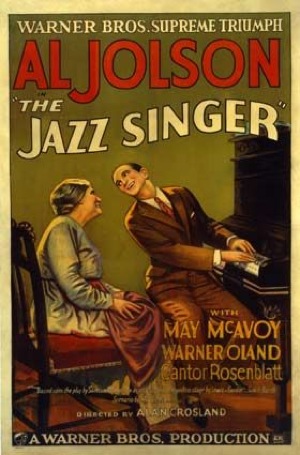
For all the attention that has been paid during the last 30 years to the early history of movie making, some of its chapters remain murky. For example, various claims have been made about who made the initial discoveries and developed the technology that made talkies possible.
Insufficient historical research is part of the problem. “Until recently, there has not been a lot of attention paid to the early years,” says Spehr, the former assistant chief of the Motion Picture, Broadcasting, and Recorded Sound Division at the Library of Congress. Once they did look into that history, “most film historians looked at movies as having started some time after World War I. They were happy to start cinema with D.W. Griffith,” he says.
Who invented what remains in contention. That has ill served Eugene Lauste. “Lauste was never able to commercially develop what he was doing with sound recording so it lingered in the background,” says Spehr. “If you look at the writing about sound movies, you won’t find his name mentioned very often.”
Among contenders for the inventor of sound-on-film is the prolific American electronics inventor, Lee de Forest, although he did not patent a sound-on-film process until 1919. Also sometimes nominated as a candidate is Thomas Edison, himself – but that is certainly an incorrect attribution, says Spehr: “Edison never worked on a sound-on-film process. He was a phonograph person who wanted to attach images to his favorite invention.”
The various false attributions arose because film historians and fans concentrated on the processes most directly related to the sound movies of the late 1920s. But by that time, Lauste’s work was already done. He had closed his south London laboratory, due to financial problems, during World War I. (During the war, notes Spehr, the British government restricted lab work and the number of patents awarded shrank dramatically which slowed the work of both Lauste and W.K.L. Dickson.)
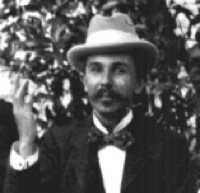
Born in the Montmartre quarter of Paris, Eugene Augustin Lauste (1857–1935) invented several devices early in his life. He came to the U.S. in 1886 and was hired as a machinist by Thomas Edison at his new lab in Orange (now West Orange), New Jersey. Lauste was among the first hires at the new lab.
The Kinetophone
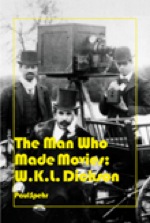
At Edison’s lab, Dickson invented the Kinetoscope camera and Kinetograph projector that were the first commercially successful movie machines; they were designed to capture images to accompany sound recorded on Edison’s Kinetophone. The commercial sound system that Edison inaugurated in 1911-1912 was a synchronized disc- cylinder**-film system, a precursor to the disc-film system later used for The Jazz Singer.
[** Clarification added 17 February 2016: The Kinetophone system, notes sound-and-film restorer Art Shifrin, debuted commercially in New York in February, 1913, and had the sound recorded on cylinders, not disks. He explains: “The playback recordings were larger than the typical consumer ‘4 minute’ format of blue celluloid molded on top of plaster of Paris cores. Their wax sub-masters were made from pantographically [mechanically] duplicated and amplified (by the Higham amplifier) dubs of the originals made simultaneously (with spring-powered recording phonographs interlocked by a belt to an electrically powered 35mm camera) when the films were shot. Comparable mechanical amplifiers (also the Higham type) were used when the prints were projected. Films and the hardware comprise part of the large collection or artifacts of The Edison National Historic Site in West Orange, New Jersey.” To correspond with the 70th Anniversary of the commercial debut of the films, two of which he restored, Shifrin published two articles about the developments, “The Trouble With Kinetophone,” (1983) ‘The Trouble with Kinetoscope’, in American Cinematographer, 1983, and “Researching and Restoring Pioneer Talking Pictures: The 70th Anniversary of the Theatrical Release of Kinetophone,” SMPTE (Journal of the Society of Motion Picture and Television Engineers), July 1983.]
Some studies have reported that Lauste was chief mechanical assistant to Dickson, but that is incorrect, says Spehr. “They were close friends, but Lauste’s work on the Kineto project was minimal. I went through the surviving work slips and Lauste did machine work, but he was particularly used on various electric and wiring projects, including a new photo building that Dickson had built in 1889.” (Spehr found that each Edison employee had a weekly work slip which recorded the hours and the number of the experiment he worked on each day.)
Lauste remained with the Edison company until 1892, when he was laid off during a general staff reduction. Probably during an extended period of unemployment during the severe depression of 1893-1894, he tried his hand at innovations in other realms. For example, he worked on a gasoline engine for motor vehicles which he abandoned because he was told that nobody would stand the noise and smell.
Dickson has come to be credited as the foremost figure in making movies possible. In addition to inventing the Kinetoscope and Kinetograph, propelled by Edison’s ideas, he also worked with George Eastman to improve long-strip photographic film.
Like Lauste, he was born in France – in le Minihic-sur-Ranse, Brittany, to an English father and a mother of Scottish descent. After his father’s death he, his mother, and his two of his sisters, who were in England, moved to the United States, probably to be near the family of his mother, who may have been born in Chesterfield County, Virginia. The family settled in Petersburg, Virginia.
Dickson had attempted to hire on to Edison’s projects even while still in England. By 1883 he was working for Edison and, in 1888, at Edison’s new lab in Orange, he began research on a device that would “do for the eye what the phonograph does for the ear,” as his boss put it.
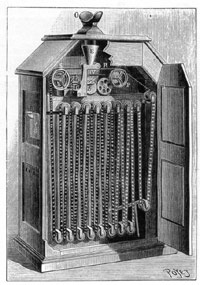
Matching sound to film was no easy matter; Dickson’s success in several other realms was more definitive. By 1891, he had succeeded in recording photographs on transparent celluloid. After managing to capture and reproduce movement, by 1892 he succeeded – as noted above – in creating the Kinetograph camera, the peep-show viewing machine called the Kinetoscope viewer, lab equipment to develop and copy negative to positive films, and other tools of the trade. The Kinetograph and the Kinetoscope both used a 35mm film format, as devised by Dickson and still employed today.
Dickson also designed the world’s first film-production studio, Edison’s Black Maria, an extraordinary facility both in its functions and its appearance. Dickson supervised production of more than 100 films for Edison.
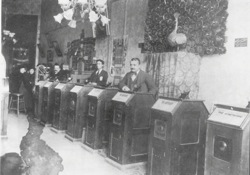
Lauste said he began work on sound-on-film at Edison’s lab, but the course of the research was not straight. Recommended by Dickson, in 1894 he joined rivals of Edison, the Latham family, who wanted to project movies. He aided them developing their Eidoloscope/Panoptikon projector as well as camera and printing equipment. He also made films using the camera. (The first was the 1895 boxing match between Young Griffo – as an Australian brawler named Albert Griffiths called himself – and Battling Charles Barnett.)
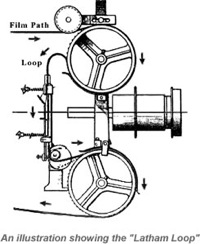
Years later, Dickson credited Lauste with inventing the “Latham loop” which permitted longer films to be made by reducing tension as the film moved through cameras and projectors.
Spehr notes that it will probably never be clear who designed the Lathams’ projectors and camera. “It’s an interesting mystery,” says Spehr. The Latham sons, Grey and Otway, had little technical expertise; the father, Woodville, had a solid scientific background but spent much of his time in his hotel room – ailing, possibly a victim of the bottle. Dickson visited frequently, sometimes several days a week. It is known, says Spehr, that the Lathams projected films for the public – at least in something resembling the modern format – earlier than even the Lumiére brothers in Paris. Says Spehr: “Things went swimmingly, but the business collapsed as other projectors appeared.”
Dickson was drawn to the Latham undertakings, too, much to Edison’s dissatisfaction, as we shall see. But meanwhile, by 1894 or 1895, Dickson created a test film for Edison’s “Kinetophone” project. It was the first attempt to synchronously record sound and moving images. The experiment failed, but left an amusing record, a film that shows a large cone – the “microphone” for the wax cylinder recorder (off-camera), and two men dancing.The Library of Congress had the film for some time and the wax cylinder with the sound was at the Edison National Historic Site. No attempt to join the two was made until the 1990s when techniques were available to handle the cylinder which was cracked. The project was supervised by Patrick Loughney, the curator of Film and Television at the Library of Congress and the sound recording was arranged by Leonard DeGraaf of the National Park Service. The cylinder was repaired and re-recorded at the Rodgers and Hammerstein Archive of Recorded Sound at the Lincoln Center in New York.
That work took so long, explains Spehr, because the cylinder was in no shape to be moved to Washington. “Copying cylinders is a tricky affair, requiring a skilled technician and the repair of cracked cylinders is a particularly specialized matter,” he notes. “By the 1990s this was much more feasible, but it took some careful negotiating to work it out.”
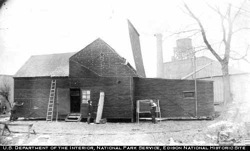
At the urging of Rick Smidlin, who did a restoration of von Stroheim’s Greed, Loughney also sent the restoration of the Dickson experimental sound film – a videotape of the 17-second film and an audiocassette of 3 minutes and 20 seconds of sound – to multi-Oscar winner film editor and sound designer Walter Murch.
Murch digitized the media and used digital editing software to synchronize image and sound, closing a loop that had been broken for 105 years. Murch and fellow film editor Sean Cullen then made the resulting 35mm film available for general viewing on the Internet Archive.
Dickson left Edison in 1895 amidst controversy over his collaboration with the Latham family. At the end of 1895 he joined three friends, Elias B. Koopman, Harry Marvin and Herman Casler to set up the American Mutoscope Company, which later became the American Mutoscope & Biograph, then Biograph. The company became Edison’s principal rival.
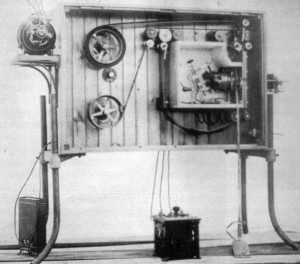
As much as Lauste has been lost to history, at least one historian, Gordon Hendricks, considered him the most important contributor to motion-picture invention in the United States after Dickson and Edward Muybridge. History has not been so kind, but Spehr and others attribute that to Lauste’s bad luck, poor management and inability to communicate well in English, as much as anything.
Intent on impressing sound and image onto celluloid, Lauste began in 1900 to construct machinery to serve the purpose. Leaving French Biograph, he moved to London to work in Dickson’s new laboratory, and in 1904 built a crude apparatus that he and his backers patented in August, 1907. They claimed “a new and improved method of and means for simultaneously recording and reproducing movements and sounds.”
He worked at Dickson’s London laboratory from about 1902 to 1908 and much of his early sound-on-film experiments were done there, but Dickson did not take part in them – he stopped making film in about 1902 or 1903, and worked on other projects. In 1908 Lauste set up his own laboratory in Brixton, south London and much his final experimenting was done there.
On the website, Who’s Who of Victorian Cinema, Stephen Herbert relates that Lauste “experimented with light valves and oscillating mirrors to find a workable method of producing the necessary narrow beam of light, and by 1910 had achieved success with a vibrating wire acting between the poles of two magnets. About that time he started an association with German experimenter Ernst Ruhmer who had some success with recording sound optically with the ‘Photographone,’ and in 1910 Lauste took his first experimental sound films in the garden of his home at Brixton, London. During a 1911 trip to America he demonstrated his camera-projector, and shot at least one short sound film, and in 1912 began experiments to devise a pneumatic amplifier for his system.”
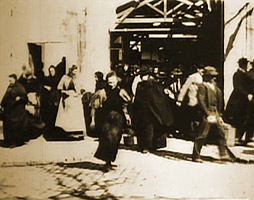
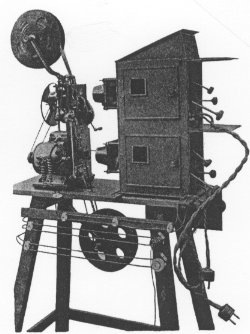
Lauste was living in dire poverty in the late 1920s when Bell Laboratories, alerted by a favorable article about Lauste written by film historian Merritt Crawford, paid him handsomely to restore all the equipment he had worked on, although the company did not buy his patent.
By 1930 Lauste had received an award as a lifetime member of the Society of Motion Picture Engineers, and he lived in relative comfort until his death in 1935. Bell gave his collection to the Smithsonian, where it resides. (Accetturo, the collector who owns the clip featured on the History Detectives program, is reportedly seeking to sell his collection, which is also large and includes much correspondence between Lauste and other film pioneers. Spehr is hoping to find a buyer willing to donate the collection to the Smithsonian.)
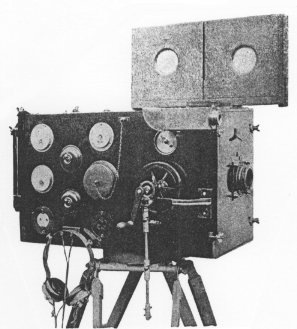
Dickson was far from idle, himself. By the end of his career in 1902 he had produced between 500 and 700 films. Highlights of Dickson’s filmmaking include records of 19th-century and early 20th-century vaudeville, circus, and Broadway, as well as some sporting events of the time. Among his subjects were world heavyweight champion “Gentleman” Jim Corbett, Annie Oakley, theater legend Joseph Jefferson performing as Rip Van Winkle, a campaign film for William McKinley (the first); and the coronation of Queen Wilhelmina of Holland. His film of Pope Leo XIII was considered the most important film event of the 1890’s.
As for Dickson’s ill-fated partner, Spehr says: “Poor Mr. Lauste has languished in the background for too long.”
Printed from Moving Image Archive News: http://www.movingimagearchivenews.org
URL to article: http://www.movingimagearchivenews.org/detecting-the-history-of-sound-on-film/
Click here to print
